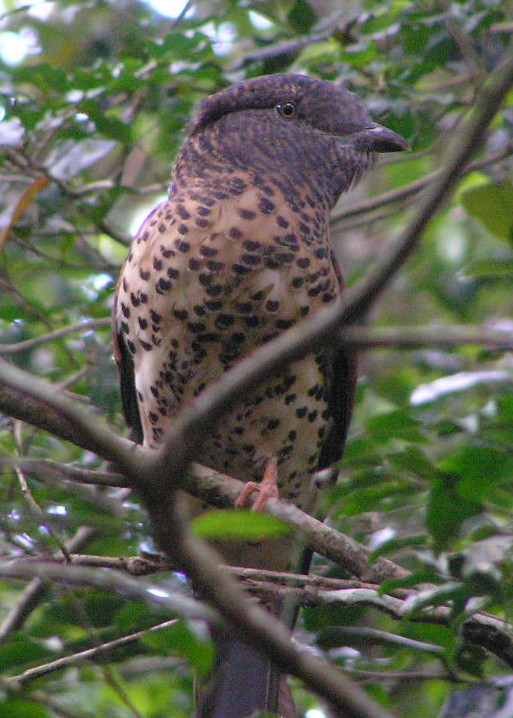- Cuckoo-roller
Taxobox
name = Cuckoo Roller

image_caption = Female or juvenile cuckoo roller
status = LC | status_system = IUCN3.1
status_ref = [IUCN2006|assessors=BirdLife International |year=2004|id=47676|title=Leptosomus discolor|downloaded=11 May 2006 Database entry includes justification for why this species is of least concern]
regnum =Animal ia
phylum = Chordata
classis = Aves
ordo = see text
familia = Leptosomatidae
genus = "Leptosomus"
genus_authority = Vieillot, 1816
species = "L. discolor"
binomial = "Leptosomus discolor"
binomial_authority = (Hermann, 1783)The Cuckoo-roller, "Leptosomus discolor", is the only
bird in the family Leptosomatidae, which is usually considered to be within the orderCoraciiformes , which also includes thekingfisher s,bee-eater s androller s. However, the position of this family is not very clear. Morphological evidence has been quoted for a placement within or near toFalconiformes . In the rather comprehensive DNA study by Hackett "et al" [Hackett, S. "et al" (2008) "A Phylogenomic Study of Birds Reveals Their Evolutionary History " "Science" 320 (5884) 1763 - 1768] this is one of only two birds -besides the Hoatzin- of which the position is not clear, although it seems to be at the root of a group that contains the trogons, the hoopoos, the woodpeckers and the rest of the Coraciiforms.It is also commonly known to English speakers by its French name courol.Goodman, S (2001) "Family Leptosomatidae (Cuckoo-roller)" in del Hoyo, J.; Elliot, A. & Sargatal, J. (editors). (2001).
Handbook of the Birds of the World . Volume 6: Mousebirds to Hornbills. Lynx Edicions. ISBN 848733430X]It is a medium-sized bird, inhabiting forests in
Madagascar and theComoros Islands. There are three subspecies; the nominate "L. d. discolor" is found in Madagascar andMayotte Island , "L. d. intermedius" onAnjouan , and "L. d. gracilis" ofGrand Comoro .Description
Unlike the true rollers and
ground roller s, where the sexes have identical appearance, the male and female Cuckoo-roller have distinctiveplumage s. Males are mostly velvety grey. The back, tail, and wings are dark shiny blue-green (green in the Grand Comoro subspecies), and a black eyestripe. Females and young birds are mostly brown marked with darker streaks. The bill is stout and the eyes set far back in the face. The legs and feet are small, and the feet have an unusual structure which has confused many ornithologists, but is now thought to be zygodactylous. The diet of the Cuckoo-roller is not well known, but a 1931 expedition found thatchameleon s andinsect s, particularly locusts and caterpillars are important food items. Stomach have often been found lined with the hairs of caterpillars, and other prey taken include grasshoppers,cicada s, stick insects andgecko s. the principal foraging technique is to perch motionless watching for prey, then to make a quick sally towards the prey when observed. They will also forage from the air.prey is caught in the large bill and dispatched by beating it against a branch.Very few studies have investigated the breeding biology of the Cuckoo-roller. It has been described in the past as a polygamous breeder, but there is no evidence for this. The nest is located in tall trees, 4-6 m off the ground, in natural cavities. No lining is placed inside the cavity, the white eggs are laid directly on the bottom. The usual clutch size is around four eggs. Incubation is performed by the female only, with the male feeding her while she is in the nest. The incubation period is about 20 days, after which fluffy chicks are born. Chicks remain in the nest for 30 days before fledging.
Relations with humans
The Cuckoo-roller is described as being very tame, and it is generally not disturbed by the inhabitants of Madagascar, many of which have legends and myths about the species. It is regarded by many as a good omen and the harbinger of clear weather. It tendency to be seen in pairs also has brought about an association with couples and love. The species is not generally hunted and has proven resistant to habitat change that has threatened other natyive birds, and is considered
least concern by theIUCN .References
External links
* [http://ibc.hbw.com/ibc/phtml/especie.phtml?idEspecie=3502 Cuckoo Roller videos] on the Internet Bird Collection
Wikimedia Foundation. 2010.
